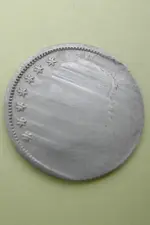I strongly stand by my initial answer and decided to e-mail the picture to my coin dealer who I have dealt with for over 20 years now. Here is his answer, which I hope will put to rest the thought that this is post mint damage. I hope it also helps the original poster with his question.
Hi Greg,
I’m not a certified expert on errors, (there are people who just specialize in these things, and see 100's in a week) but as you know I have been in this business for over 40 years and on viewing the picture my first initial reaction was “wow, cool error”. This is not man-made damage. Actually, I don’t see any “damage” at all. Damage is a term that we reserve for something that has happened post minting. What occurred here happened “during” minting, which is what differentiates an error from damage. So now we need to ask ourselves, how did this occur? With the amount of pressure and force needed for a human to inflict this amount of damage the very first thing you would notice is that coin would be out of round. This coin appears to be perfectly round. Also If you notice at 5 o clock there is what appears to be a star (albeit larger) and substantially down farther than it should be in the position where the fourth number of the date would be. This would lead me to believe that the planchet may have moved quickly and suddenly in the striking process and this would also definitely explain the striation lines (from the pronounced stars to the left) moving in the direction of where the larger star (at 5 o'clock) seems to have shifted.
What's weird Greg is that the doubling of the capped bust, if it did shift in left to right motion it would not look like it does with the upper head more raised and to the left of the lower or bottom edge of the capped bust, which to me indicates a doubling or second strike in quick combination with a faulty ejection. So now we’re talking about a combination error. I hope I have helped you. This is the great fun in coin collecting finding these oddities.
Regards,
Mike





